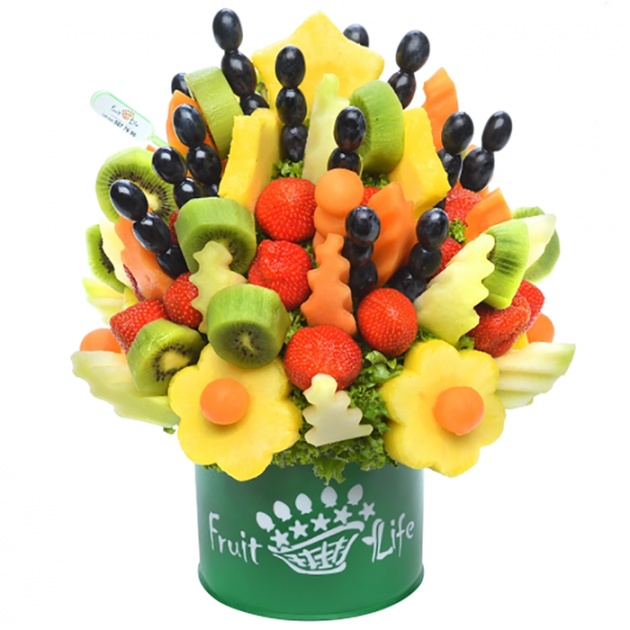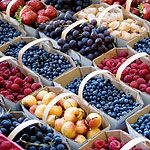



Fruits are not only delicious but healthful too. Rich in vitamins A and C, plus folate and other essential nutrients, they may help prevent heart disease and stroke, control blood pressure and cholesterol, prevent some types of cancer and guard against vision loss. They're so good for you that Health Canada recommends that most women get seven or eight servings of fruit and vegetables each day.
If it's the vitamins that promote good health, you may wonder if you can just pop supplements. Nope. Sun-drenched peaches and vine-ripened grapes contain more than just vitamins; they're a complex combination of fibre, minerals, antioxidants and phytochemicals – as well as the vitamins – that work in combination to provide protective benefits. You can't get all that from a pill.
All fruits offer health benefits, but the following 25 stand out as nutrient-dense powerhouses with the most disease-fighting potential.
Apple
• Nutritional value (1 medium): 75 calories, 3 g fibre
• Disease-fighting factor: Apples contain antioxidants called flavonoids, which may help lower the chance of developing diabetes and asthma. Apples are also a natural mouth freshener and clean your teeth with each crunchy bite.
• Did you know? An apple's flavour and aroma comes from fragrance cells in apple skin, so for maximum flavour, don't peel your apple. Plus, the vitamins lie just beneath the skin.
Avocado
• Nutritional value ( ½ avocado): 114 calories, 4.5 g fibre, source of vitamin E and folate
• Disease-fighting factor: Avocados contain healthy monounsaturated fats that can help lower cholesterol levels when eaten instead of harmful saturated fats. For a heart-healthy boost, replace butter with avocado on your favourite sandwich.
• Did you know? Babies love avocados. Their soft, creamy texture makes them easy to eat, and their high fat content helps with normal infant growth and development.
Banana
• Nutritional value (1 medium): 105 calories, 3 g fibre, source of vitamin B6, potassium and folate
• Disease-fighting factor: With 422 milligrams of potassium per banana, these sweet delights have more potassium than most fruit and may help lower blood pressure levels.
• Did you know? People with rubber latex allergies may also be allergic to bananas since the two come from similar trees and share a common protein.
Blackberry
• Nutritional value (1/2 cup/125 mL): 31 calories, 4 g fibre, rich in antioxidants
• Disease-fighting factor: Blackberries get their deep purple colour from the powerful antioxidant anthocyanin, which may help reduce the risk of stroke and cancer. Studies show that blackberry extract may help stop the growth of lung cancer cells.
• Did you know? The ancient Greeks called blackberries "gout-berries" and used them to treat gout-related symptoms.
Blueberry
• Nutritional value (1/2 cup/125 mL): 41 calories, 1.5 g fibre, rich in antioxidants
• Disease-fighting factor: Blueberries rank No. 1 in antioxidant activity when compared to 60 other fresh fruits and vegetables. Blueberries may help lower the risk of developing age-related diseases such as Parkinson's and Alzheimer's.
• Did you know? Blueberries freeze very well. Here's how: Rinse, then let berries dry in a single layer on towels. Freeze in a single layer on rimmed baking sheets. Seal in freezer-safe containers for up to one year. Use them straight from the freezer in your morning cereal, blend them into a smoothie or mix into pancake or muffin batter. (You can also buy frozen blueberries year-round.)
The serving size listed for each fruit in our glossary counts as one serving in Canada's Food Guide. The number of servings you need each day depends on your age and gender. For example, women between the ages of 19 and 50 need seven to eight servings of fruit and vegetables each day (three fruit and four vegetable servings would suffice). To determine the correct number of vegetable and fruit servings for you, visit the Health Canada website (www.hc-sc.gc.ca) at and search for "food guide."
Cantaloupe
• Nutritional value (1/2 cup/125 mL): 25 calories, less than 1 g fibre, source of vitamin A, folate and potassium
• Disease-fighting factor: Cantaloupe is high in the antioxidant beta-carotene, which may help reduce the risk of developing cataracts. Cantaloupe is a perfect diet food since it has about half the calories of most other fruits.
• Did you know? Since bacteria can grow on the outside rind, it is important to wash cantaloupe before cutting into it.
Cherry
• Nutritional value (1/2 cup/125 mL): 46 calories, 1.5 g fibre, rich in antioxidants
• Disease-fighting factor: Sour cherries contain more of the potent antioxidant anthocyanin than any other fruit. Anthocyanin may help reduce inflammation and ease the pain of arthritis and gout.
• Did you know? Sour cherries, commonly used in pie and jam, have more vitamin C than sweet cherries do, but much of it is lost when they are heated.
Cranberry
• Nutritional value (1/2 cup/125 mL): 25 calories, 2.5 g fibre, rich in antioxidants
• Disease-fighting factor: Cranberries are antibacterial and studies show that they can help treat and prevent urinary tract infections. Recent research has also linked cranberries to the prevention of kidney stones and ulcers.
• Did you know? Unsweetened cranberry juice makes an excellent mouthwash – studies show it can help kill bacteria and fight cavities.
Fig (dried)
• Nutritional value (2 dried figs): 42 calories, 1.5 g fibre, source of potassium, calcium and iron
• Disease-fighting factor: High in fibre, figs may help reduce the risk of heart disease.
• Did you know? Puréed figs make an excellent substitute for fat (like butter or oil) in baked goods. Simply purée 1 cup (250 mL) of dried figs with 1/4 cup (50 mL) of water, then replace half of the fat called for in the recipe with an equal amount of the fig mixture.
Goji berry
• Nutritional value (1/2 cup/125 mL): 90 calories, 2.5 g fibre, source of vitamin A,
rich in antioxidants
• Disease-fighting factor: Goji berries are a nutrient powerhouse, containing six vitamins, 21 minerals and a slew of antioxidants. They have been linked to the prevention of diabetes and cancer, but more research is needed to understand their effects.
• Did you know? Dried goji berries, which look like dried cranberries, can be found in most health food and bulk stores.
Note: Health Canada has warned people using the prescription drug Warfarin to avoid goji berries, because they can alter the drug’s effectiveness.
Grape
• Nutritional value (1/2 cup/ 125 mL): 53 calories, less than 1 g fibre, source of manganese
• Disease-fighting factor: Grapes contain resveratrol, an antioxidant that may help prevent heart disease by reducing blood pressure levels and lowering the risk of blood clots. Resveratrol may also help stop the spread of breast, stomach and colon cancer cells.
• Did you know? You can freeze red and green grapes and use them as colourful ice cubes in your favourite drinks. They add a special touch to sparkling water or Champagne.
Grapefruit (pink)
• Nutritional value (1/2 grapefruit): 52 calories, 2 g fibre, source of vitamin A
• Disease-fighting factor: Pink grapefruit contains lycopene and flavonoids, which may help protect against some types of cancer. Grapefruit also boasts an ample supply of pectin, a soluble fibre that may help lower cholesterol levels.
• Did you know? Grapefruit can heighten the effect of certain drugs, including cholesterol-lowering statins. Check with your pharmacist to see if grapefruit may interfere with any of your medications.
Kiwifruit
• Nutritional value (1 large): 56 calories, 3 g fibre, source of vitamins C and E, and of magnesium and potassium
• Disease-fighting factor: With more vitamin C than oranges, kiwis can help in the development and maintenance of bones, cartilage, teeth and gums. They can also help lower blood triglyceride levels (high triglycerides increase the risk of heart disease).
• Did you know? Most people remove the fuzzy skin, but kiwis can actually be eaten whole – skin and all.
Mango
• Nutritional value (1/2 medium): 54 calories, 1.5 g fibre, source of vitamins A and E
• Disease-fighting factor: Mangoes are high in the antioxidants lutein and zeaxanthin, which may help protect vision and reduce the risk of age-related macular degeneration (the leading cause of blindness in adults).
• Did you know? Mangoes can be enjoyed ripe as a sweet, juicy dessert choice or unripe as a sour, crunchy addition to chutney and salads.
Orange
• Nutritional value (1 medium): 62 calories, 3 g fibre, source of vitamin C, folate and potassium
• Disease-fighting factor: Oranges are a good source of folate, an important vitamin for pregnant women that can help prevent neural tube defects in their infants. They also contain a phytochemical called hesperidin, which may lower triglyceride and blood cholesterol levels.
• Did you know? The edible white part of the orange rind has nearly the same amount of vitamin C as the flesh, so eat that part too!



